If I Update My Phone Will I Lose Everything? Knowing the Risks and Solutions
"If I update my iPhone will I lose everything?" You are not alone in asking this question! Many people worry about this. In fact, don't worry, updating your phone doesn't mean you have to say goodbye to all the data on your phone. Upgrading your iPhone can provide better performance for your phone and keep your device running more smoothly and securely. Let's delve deeper into this topic now, we'll explore why it's necessary to update your phone, what happens when you update your phone, and how to make sure you don't lose data while updating your phone.
Part 1: If I Update My iPhone Will I Lose Everything?
What Does Updating Your Phone Mean?
Updating your iPhone means installing the latest software version from the manufacturer. On the one hand, it includes system upgrades to improve functionality, solve problems, and add new features to the operating system. On the other hand, it also includes application upgrades, which enhance specific applications loaded on the device. These upgrades keep your phone safe and functional. Updating the iPhone will fix vulnerabilities to ensure that the device is compatible with updated services and applications. It will also help defend against cyberattacks and ensure the security of the device.
If you refuse to update your iPhone system or apps, your gadgets may not work with the latest software, and security holes may appear. Therefore, we need to update our phones from time to time so that they continue to function properly, remain secure, and are compatible with new technologies.
What Data Is at Risk During an Update?
Will updating my phone delete anything? Well, normal iPhone upgrades will not cause data loss, but some iPhone data may be lost due to some uncertain factors, such as insufficient storage space, poor network connection, or insufficient battery. Among them, contacts, images, and apps are some typical data types on the device that may be compromised during the upgrade process.
The contacts, images, and videos, as well as app data (including preferences, settings, login information, etc.) may be compromised if you do not back them up properly before doing so. This is because contacts and images are typically saved on the device's internal storage and may not be automatically backed up to the cloud without settings, so they may be more susceptible to loss than other types of data. It can be seen that it is very important to regularly back up all important data on your iPhone to avoid losing it during the update process. (How to back up iPhone photos?)
You May Be Interested in:
- iPod Won't Sync with iTunes? 10 Easy Solutions to Fix It!
- What if iPhone Won't Restore? Here Are the Full List of Fixes
Part 2: How to Update iPhone without Losing Data?
Updating your iPhone typically should not result in losing all of your data. However, it's essential to take precautions to avoid any potential data loss during the update process. Here's what you need to know:
Tip 1: Back up Your iPhone
Before updating your iPhone, it's crucial to back up all your data. You can do this using iCloud or iTunes on your computer.
How to back up your iPhone using iTunes:
- Connect your iPhone to your Mac or PC using a USB cable. To ensure a successful connection, be sure to unlock your iPhone and let it trust this computer.
- Generally, iTunes will open automatically after the iPhone is successfully connected. No, please start it manually.
- In the upper left corner of the iTunes interface, click your iPhone icon to select it.
- Go to your iPhone's Summary tab > Backup section > Select "This PC" as the location to store your backup.
- Click the "Backup Now" button to start the backup process. Once completed, all data on your iPhone, including applications, settings, photos and other content, will be successfully backed up to your computer through iTunes.
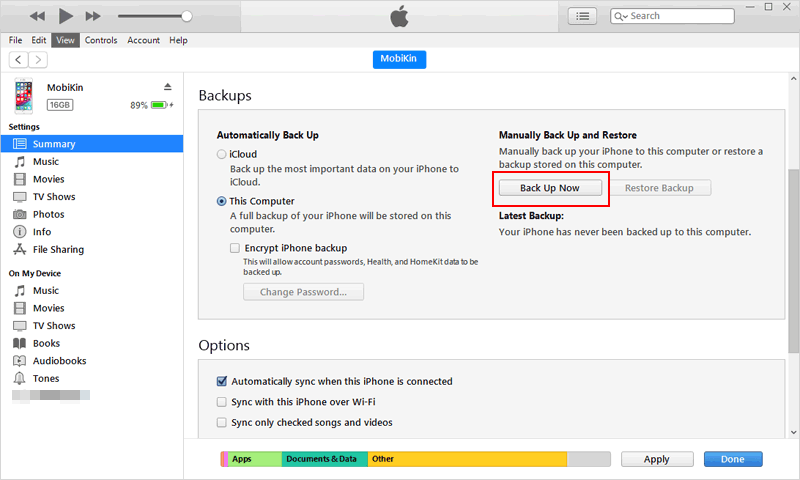
In the future, if your device encounters data loss, software problems, or you need to reset a new device, you can use this iTunes backup to restore your iPhone.
How to back up your iPhone using iCloud:
iCloud allows you to back up settings, app data, messages, photos, and more on your device. Making iCloud backups is very convenient. Once you enable iCloud backup on your iPhone, iCloud backups will occur automatically whenever your device is connected to WiFi, plugged in, and locked.
- Connect your iPhone to a stable Wi-Fi network.
- Open the Settings app on your iPhone and tap your name at the top of the screen.
- Scroll down and select iCloud.
- In iCloud settings, click "iCloud Backup" and toggle the "iCloud Backup" switch to the "On" position.
- Click "Back Up Now" and your iPhone will start backing up data to iCloud immediately.
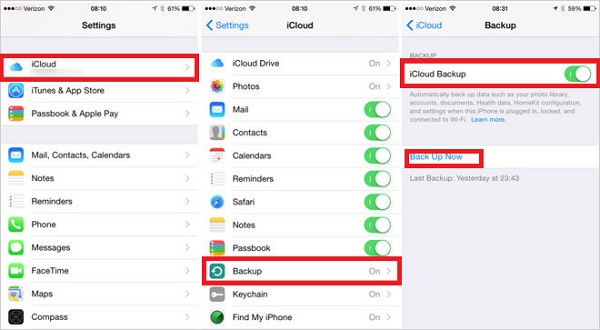
The iCloud backup process may take some time, depending on the amount of data on your iPhone and the speed of your Wi-Fi connection.
As you can see, whether you use iTunes or iCloud to back up your iPhone, they do not allow you to preview and select specific data. If you need to back up specific iPhone content, such as contacts, photos, or videos, you can use the method recommended in part 3 to preview and select the backup content before backing up.
Tip 2. Check Storage Space
Please make sure you have enough storage space on your iPhone for the upgrade. If you find that your iPhone is running out of storage, you can make space by deleting unused data or apps. Here are the steps on how to check iPhone storage space:
- On your iPhone's Home screen, tap Settings > General > iPhone Storage.
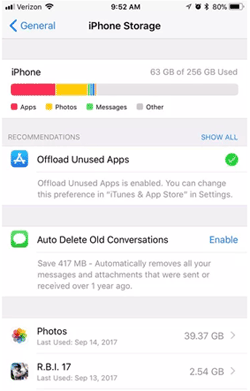
You can now view the total amount of storage, the amount of used space, and the available space on your device on the iPhone storage screen.
Tip 3. Connect to a Stable Wi-Fi
Because Software updates can be large, large amounts of cellular data are consumed. Therefore, before starting the software update, make sure your iPhone is connected to a stable Wi-Fi network, which will help prevent unexpected data charges and ensure a smoother update process.
- Open the "Settings" app on the iPhone home screen.
- In the Settings menu, select Wi-Fi.
- From the list of available Wi-Fi networks, select the network you want to connect to, enter your password and click Join or Connect.
Tip 4. Charge Your iPhone
To make the iPhone update process go smoothly, be sure to make sure your iPhone is fully charged or connected to a power source before starting the update. The purpose of this is to prevent unexpected interruptions due to low battery power during the update process.
Tip 5. Accurately Update Your iPhone
After confirming that you have backed up your iPhone data, that you have enough storage space on your iPhone, that you are connected to a stable Wi-Fi network, and that your iPhone's battery power is sufficient, you can start the iPhone update process.
- Navigate to the Settings app on your iPhone Home screen > tap General > select Software Update. Then follow the on-screen prompts to download and install the latest updates for your iPhone.
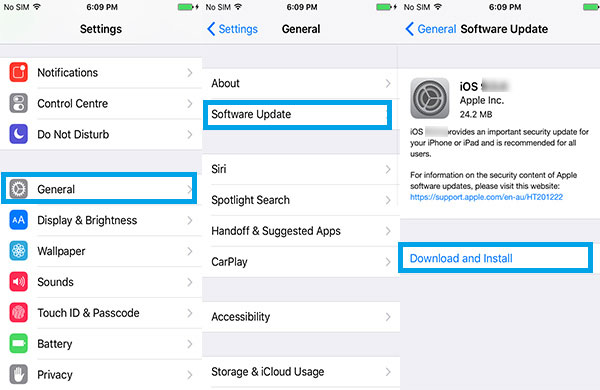
Upgrading your iPhone will take a while. Please be patient and do not interrupt the process to ensure a successful update.
Tip 6. Post-Update Check:
Once the update is complete, you can check your iPhone to see if all data and apps are intact. Once you encounter any problem or notice data loss, you can restore your iPhone from the backup you created earlier.
Well, by following the necessary precautions above, you should be able to safely update your iPhone without losing data. All in all, it is always a good practice to back up your device regularly to prevent any potential data loss in the future.
You May Be Interested in:
- How to Recover Deleted Photos from iPhone or iTunes Backups
- How to Access iPhone Files on Windows/Mac (Way 1 Is Versatile)
Bonus: Back up Your iPhone Selectively with Assistant for iOS
As mentioned above, iTunes and iCloud do not allow users to preview and select specific data for backup. Here, we sincerely recommend you MobiKin Assistant for iOS, which provides the most effective method for you to selectively back up iOS files. This means you only need to back up the files that are important to you, which can save you a lot of time and storage space. Furthermore, it allows you to manage and edit iOS data on your computer directly.
See how to back up data from your iPhone to computer with Assistant for iOS:
Step 1: Download and install Assistant for iOS onto your computer. Launch the software and connect your iPhone device to your computer. When the connection is successful, the main menu page of program will display your iPhone.

Step 2: On the left side menu, you will find all the files on your iPhone and ready for backup. You can check the file types you need and Assistant for iOS will start to scan your device.

Step 3: After the scan, you can preview and select the data you want to back up. Once you are satisfied with your selection, click "Export" on the top of the page to kick off the backup process.
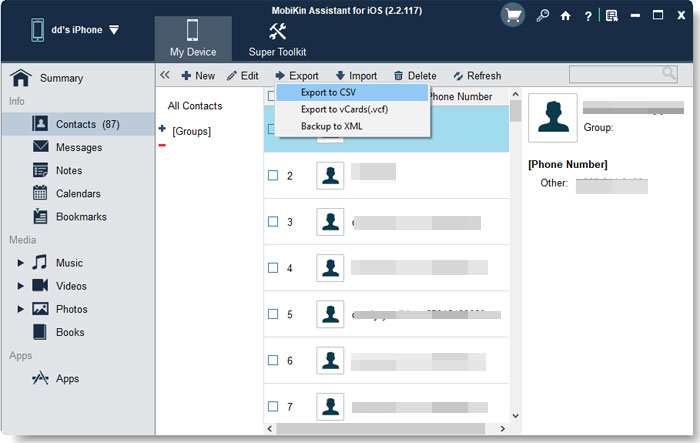
Wait for the backup to be finished. You will be notified when the backup has been completed successfully.
Summary
If you ask "Does updating your phone delete anything"? I want to say that nothing is absolute. If you're worried about data loss, it's a good idea to back up your iPhone data. As long as you use reliable method to back up iPhone data, there is nothing to worry about. You can use MobiKin Assistant for iOS to selectively back up data, or you can use iTunes or iCloud. Do as you wish.
Related Articles:
How to Extract iPhone Photos from Backup Files
How to Solve iPhone Notes Icon Missing or Hidden Issue?
How to Undelete Notes on iPhone 15/14/13/12/11/X/XR/8/7/6
How to Restore Notes on iPhone from iCloud [3 Ways Included]
[Solved] How to Recover Deleted SMS from iPhone/iPad
3 Simple Steps to Transfer WhatsApp Backup from Google Drive to iCloud



